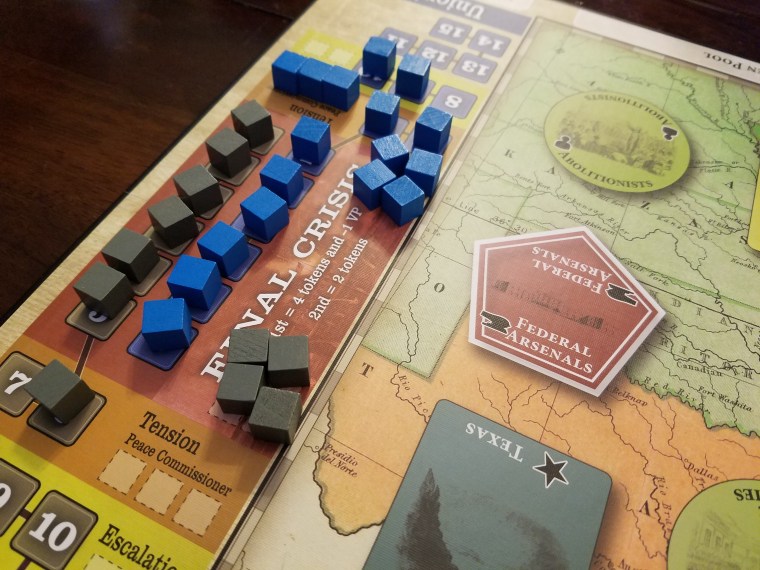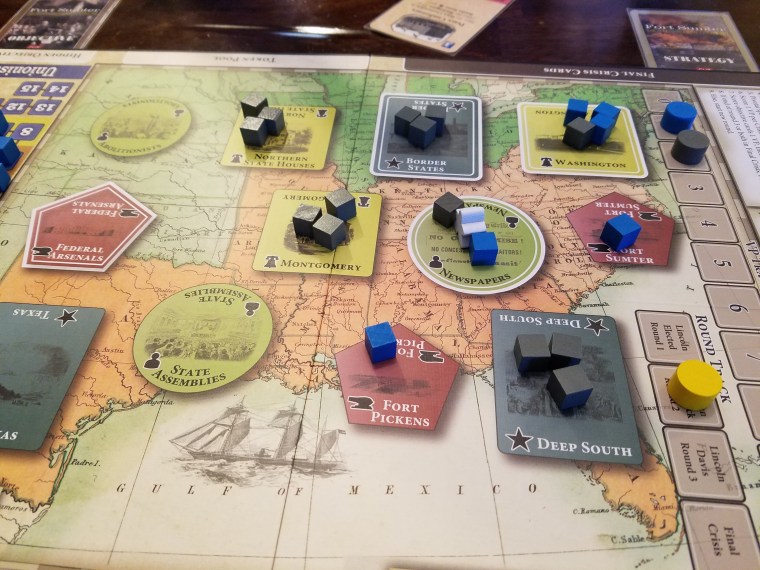There’s something about Mark Herman that consistently draws me to his designs. He’s a master at linking a fascinating historical narrative to a compelling framework of mechanisms. While an outsider could describe wargames as dry and uniform, Mark’s work tends to push outside the genre’s boundaries and establish unique story-driven personalities. Games like Churchill, Pericles, and Fire in the Lake maintain the feel of military dudes looking over military maps, but they challenge ingrained concepts and push the genus into previously unthinkable directions.

Fort Sumter: The Secession Crisis, 1860-1861 is sort of a different animal. The concept of presenting a 20-30 minute area control game for two players is rock solid, particularly one that attempts to capture a historical series of events through politics and arenas that are in opposition to violence. It’s interesting, simple, and relatively effective.
There is a minor identity predicament as we’ve seen this trick before in the 2016 release 13 Days: The Cuban Missile Crisis. Many of the concepts are shared and Herman even makes a veiled nod toward the game in the designer notes, avoiding calling the title out explicitly by name. They both highlight bleak political struggles bordering on war, presented as an abbreviated card-driven game (CDG) in the vein of We the People or Twilight Struggle.
That’s not to say Fort Sumter doesn’t forge its own path. You’ll immediately notice that it jettisons the DEFCON meters for a crisis track that forms the supply for players to draw from. If you want to push the political and economic battlegrounds on the map you need these cubes that represent constituents and support. Pushing hard down your party line for political backing naturally entrenches the opposition and hardens those on the sidelines. This is all wonderfully represented by that crisis track which punishes you for escalating too swiftly.

That decision point couples well with jockeying for area majority in the battlegrounds. Spaces are separated into different crisis dimensions, each representing a sphere of contention leading up to the war such as armaments or public opinion. Each such dimension is split into three spaces on the board raring to be fought over and dominated.
That segregating of political vectors into different types forms the bulk of scoring and manipulation in the design. It’s the stage for which you’ll debate and eventually trade shot and blood. You must control all three spaces of a specific dimension in order to score a victory point, making for a bit of nuance in how you aggressively pursue locations.
Co-mingling with this strategic deployment are secret objective cards. Each player chooses between two each round which dictate a specific area of high priority. This mechanism can alter your tactical decision matrix as you look to squeeze every last point from the pulpy charred remains adorning the table.

Fort Sumter lives and dies on its tense maneuvering. There’s a tug-of-war atmosphere as several of the interlocking mechanisms pit players on directly opposite sides of the rope. Flowing from this atmosphere is the tight feel of the game state. Each action you’re manipulating a small number of political clout cubes, tossing them out into an area and staking your claim. Large dramatic swings due to some wild events do occur, but they’re relatively infrequent as play is more measured and constricted.
Contrasting with that pinched flow is the multitude of opportunities for scoring. There are several crisis dimensions and the lack of dramatic maneuvers makes it difficult to put up much of a defense. This leads to players typically carving out their own areas and mainly pushing offensively towards their goals. It can be extraordinarily difficult to overcome a player who has already established a support base in a zone, so that conundrum often pushes you towards an open area, of which there are often several.
Compounding this focus on offense are those randomized objectives. Regularly you will luck into a card that you already have well-secured and virtually locked up. This can sap some of the tactical variety as a mechanism intended to provide a contrasting vector of pursuit fades into the shadow of the larger more steady goals.

The game ultimately comes down to a couple moments of decisive maneuvering. This typically occurs via a strong event play or the final crisis – a closing act that has you sacking away cards towards a climactic standoff. You can invariably trace your performance to those few key moments and realize where it all went sideways.
That reduction in quantity of dynamic plays is the driving force behind this game’s penchant for narrow point deltas. Nearly every session will come down to just one or two victory points, hinging on those significant maneuvers as well as the key decision of whether to broach the final crisis zone when retrieving cubes.
This blunting of the design’s charm is a byproduct mainly of the time compression. In order to flatten the playtime some of the more interesting and lively bits of the established genre had to be lopped off.
And with that I’m a little at odds. Mark Herman seemingly accomplished his design goals with this release, but it’s short of a triumphant home run. It’s certainly an interesting game that begs repeated play, but it’s also not quite there in terms of attaining an element of overt fascination or excellence.
What’s particularly interesting is that the philosophical conundrum present in the subject matter runs parallel to the mechanical challenges. The outcome of the game results in a thematic interpretation of either the North or South galvanizing themselves for war, ever ready for the oncoming catastrophe. While I defer to Mark Herman’s historical knowledge (I am but an ant and he the man towering above), it comes across a little soft and inconsequential. The included historical materials and essay go a long way to cultivating interest, but it feels as though a great deal of effort is put forth to convince the reader that this struggle and its outcome are significant. It ultimately lands as slight hyperbole in its attempts to pursuade, although thankfully that doesn’t undercut the interesting elements at play when engaging the game.
The word on the street is that this release is the inaugural title for an ongoing series. I’d wager a few Lincolns that Herman’s line of 30 minute CDGs will not ultimately become known for this initial release. It feels more like an opening salvo which will lead to a prolific work.
And I’m ultimately satisfied with that conclusion.
Fort Sumter may not be the metaphorical shot heard round the world, but it still proves a solid abridged experience. With proper expectations and the right mindset, this one will mostly deliver on its promise and fill its compact timeframe with just enough interesting decisions to keep you focused.
A review copy was provided by the publisher.
If you enjoy what I’m doing at Player Elimination and want to support my efforts, please consider dropping off a tip at my Ko-Fi.

Well written review. I think its probably a decent game judging from what you wrote about it. I just can’t make myself push cubes around on blandly colored boards anymore – whether they are euros or wargames. I just can’t do it. Too much Blood Rage in my system I guess. There are a few hybrid games out there where the theme and/or board or card art draws me in enough to play, like Champions of Midgard …. (although I pimped my game out with 3d figures to make it more palatable) or Eclipse (which I also pimped out with 3d everything).
War games have a huge following, although I see it more in older gamers than in young ones when I go to conventions. I wonder if the appeal of these games will still pull in the younger crowds that like their games shorter, brighter, and more filled with plastic or whether these blandly colored war games will go the way of the dodo, the 8-track, and the Avalon Hill bookshelf game.
Maybe the shorter time frame of this one will help broaden the appeal of this type of game.
LikeLike
Yeah I think their niche is dedicated. I flirt with a handful of wargames (I love Fire in the Lake, and I’m also currently playing/evaluating Pericles which could be a classic), and they definitely hit some notes that other genres don’t.
The lack of visual appeal and chrome really do make them less direct fun for a number of us gamers, as they project a tone of seriousness that can belie their potential.
I can’t imagine myself ever being a true dedicated wargamer, but I do appreciate the genre and enjoy checking out the odd title here and there. GMT is a fantastic company.
LikeLike
I guess technically this is a “getting-ready-for-war” game, but it has the same feel as a war game to me from looking at it.
LikeLike